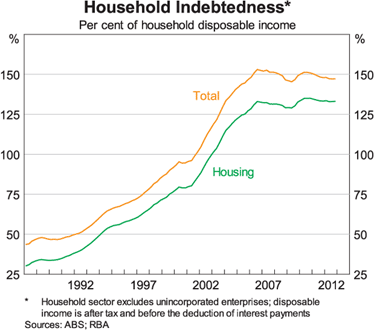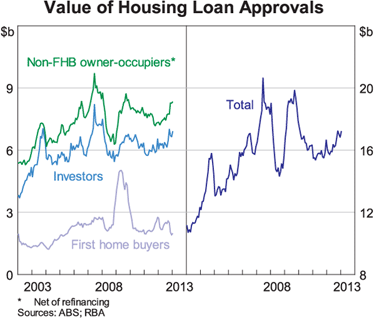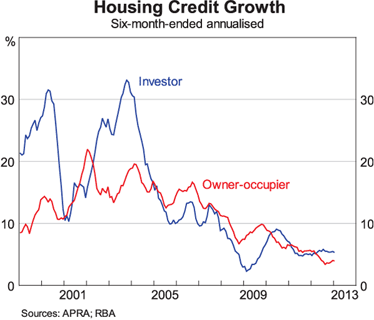
Last night the RBA delivered an interesting sermon on property prices that shows that despite an obvious reluctance to cut interest rates, the bank will not avoid the same path of lower rates for longer that we see in other nations. Nor will there will be policy innovation in the delivery of those rates. And if it takes more credit for households to boost prices property prices and construction then so be it. They want to build more houses for growth and damn the lifeboats.
Why do I say so? Here is the the RBA’s reasoning on what makes construction tick:
With interest rates low and housing prices having picked up in much of the country, more people are now confident that either housing prices will keep rising or at least not decline. We can see this in some of the available survey measures of housing price expectations. This is important for prospective entrants to the market, particularly for developers and investors, who might otherwise be wary of undertaking a new venture or purchasing a house for fear of a capital loss.
Now take a look at the following section on financing growth for the property sector:
Financing
Over the past 20 years or so, upturns in the housing market have been accompanied by an increase in the growth rate of credit. But those years were also a period of structural change as the economy moved to a higher level of household indebtedness (Graph 4). Generations of households yet to buy their first home, or still wanting to trade up, were taking advantage of easier access to credit, which among other things had been facilitated by the shift to lower inflation and lower interest rates in the early 1990s.[2] As part of this change, the household saving rate declined and housing prices increased, at times quite rapidly. With household indebtedness no longer moving up since 2006, this long period of adjustment now seems to have run its course.
Graph 4
Indeed, in recent years we have seen a rise in the household saving rate and relatively stable household debt as a share of income. This suggests that we should not expect housing credit to grow anywhere near as rapidly as it had in previous upturns. Moreover, while the recent pick-up in housing prices would tend to imply growth in housing loans – since buyers typically fund those purchases with debt – this effect will be lessened by the low level of turnover in the established housing market.
Even so, the availability of credit does not appear to be a constraint for most homebuyers and investors. The decline in mortgage interest rates since 2011 has underpinned a moderate increase in the value of total housing loan approvals over the past six months (Graph 5). This has been driven by demand from repeat-buyer owner-occupiers as well as investors.[3]
Graph 5
Despite the moderate pick-up in new lending, growth in housing credit has not increased significantly and remains broadly in line with growth in incomes at an annual rate of around 4½ per cent. Lower interest rates have given households more scope to make payments on their mortgages ahead of schedule. This means that for a given growth rate of new lending, credit growth will be a bit lower than otherwise. We can see this effect in the behaviour of owner-occupier housing credit. From early 2012, shortly after mortgage rates started to decline, owner-occupier housing credit has been growing at a slower pace than investor housing credit (Graph 6). This makes sense because the incentive to make excess mortgage payments is greater for owner-occupiers than investors given the different tax incentives they face.
Graph 6
And now read the conclusion of the paper:
A range of indicators suggest that low interest rates have been supporting the established housing market, and prices have been moving higher in many markets, though they remain below earlier peaks in most. Also, finance is available on reasonable terms for households. With these conditions in place, dwelling construction is beginning to pick up and leading indicators point to further growth in the months ahead. In line with this, our expectation is that there will be a further gradual increase in dwelling construction activity over this year and the next. This moderate growth in dwelling investment will play some role in helping to support a gradual pick-up in economic growth more broadly from what is expected to be a rate a little below trend this year. But it is hard to know exactly how strong the recovery in the housing market might be, so we’ll continue to analyse these developments closely over the period ahead.
The corollary is that if rates of credit growth are insufficient to boost property prices and construction activity then they’ll cut some more. That will mean credit growth above income growth which is going to fall further on the terms of trade correction. In my estimation it will also mean faster credit than deposit growth which implies bank’s growing offshore borrowing. This is all already happening in New Zealand where the RBNZ also has a hawkish tone but is doing nothing.
A few years ago I coined the phrase “the great disleveraging” to capture the RBA’s grand project of working off Australian household indebtedness through lowering mortgage credit growth rates and allowing the economy to grow up around them. As you can see from the top chart they had some success but the project is far from complete. Yet gone are the very public warnings of the past few years that any increase in household indebtedness from here will increase the risk profile of the country.
So far as our central bank is concerned, household, bank and national leveraging is back. Only APRA now stands in the way of a sustained ramp up in credit.




